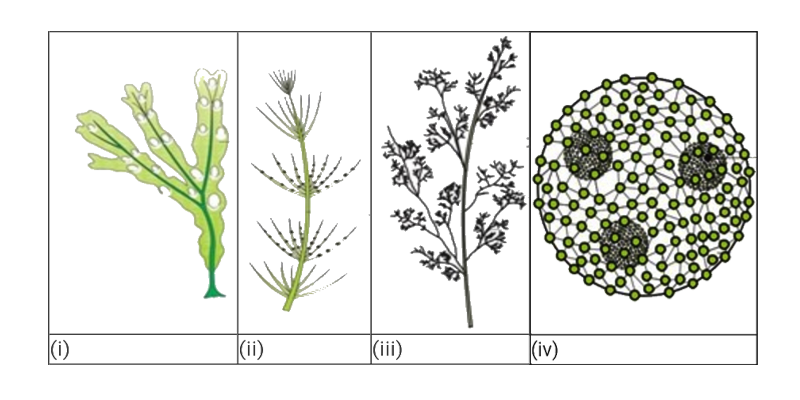With the help of a schematic diagram describe the haplo-diplontic life cycle pattern in plants.
Step-by-Step Solution:
1. Understanding the Haplo-Diplontic Life Cycle:
The haplo-diplontic life cycle is characterized by the alternation of generations, where two distinct multicellular stages occur: the haploid gametophyte and the diploid sporophyte.
2. Phases of the Life Cycle:
- Sporophyte Generation:
- The sporophyte is the diploid phase, which undergoes meiosis to produce haploid spores.
- These spores are released into the environment.
- Gametophyte Generation:
- The haploid spores germinate and develop into the gametophyte, which is a multicellular structure.
- The gametophyte produces gametes (male and female) through gametogenesis.
3. Fertilization:
- The male and female gametes fuse during fertilization (syngamy) to form a diploid zygote.
- This zygote eventually develops into a new sporophyte, completing the cycle.
4. Schematic Diagram:
- Draw a cycle that includes:
- Sporophyte (2n) → Meiosis → Spores (n)
- Spores (n) → Germination → Gametophyte (n)
- Gametophyte (n) → Gametogenesis → Gametes (n)
- Gametes (n) → Fertilization → Zygote (2n)
- Zygote (2n) → Development → Sporophyte (2n)
5. Repetition of the Cycle:
- The cycle continues as the sporophyte generation produces more spores, leading to the development of new gametophytes, thus perpetuating the haplo-diplontic life cycle.
The haplo-diplontic life cycle is characterized by the alternation of generations, where two distinct multicellular stages occur: the haploid gametophyte and the diploid sporophyte.
- Sporophyte Generation:
- The sporophyte is the diploid phase, which undergoes meiosis to produce haploid spores.
- These spores are released into the environment.
- Gametophyte Generation:
- The haploid spores germinate and develop into the gametophyte, which is a multicellular structure.
- The gametophyte produces gametes (male and female) through gametogenesis.
- The male and female gametes fuse during fertilization (syngamy) to form a diploid zygote.
- This zygote eventually develops into a new sporophyte, completing the cycle.
- Draw a cycle that includes:
- Sporophyte (2n) → Meiosis → Spores (n)
- Spores (n) → Germination → Gametophyte (n)
- Gametophyte (n) → Gametogenesis → Gametes (n)
- Gametes (n) → Fertilization → Zygote (2n)
- Zygote (2n) → Development → Sporophyte (2n)
- The cycle continues as the sporophyte generation produces more spores, leading to the development of new gametophytes, thus perpetuating the haplo-diplontic life cycle.
Topper's Solved these Questions
- BOOK - ICSECHAPTER - PLANT KINGDOM EXERCISE - Test Your Progress (HOTS)4videos
PLANT KINGDOM
- BOOK - ICSECHAPTER - PLANT KINGDOM EXERCISE - Ncert Exercises with Answers27videos
PLANT KINGDOM
- BOOK - ICSECHAPTER - PLANT KINGDOM EXERCISE - Test Your Progress (Very Short Answer Type Questions )34videos
PLANT KINGDOM
- BOOK - ICSECHAPTER - PLANT GROWTH AND DEVELOPMENTEXERCISE - NCERT EXERCISES WITH ANSWERS (DIFFERENTIATE BETWEEN)11videos
PLANT GROWTH AND DEVELOPMENT
- BOOK - ICSECHAPTER - QUESTION PAPER -BIOLOGYEXERCISE - PART -II (Section -C)6videos
QUESTION PAPER -BIOLOGY
Similar Questions
Knowledge Check
- Question 1 - Select One
Haplo-diplontic life cycle is found in
AbryophytesBpteridophytesCfungiDboth a and b
Diplontic life cycle is found in:-
View SolutionAlgal member with diplontic life cycle is
View SolutionExplain the principle and working of a cyclotron with the help of a schematic diagram. Write the expression for cyclotron frequency.
View SolutionWhich of these algae have a haplo - diplontic life cycle ?
 View Solution
View SolutionDiplontic life cycle is seen in ________.
View SolutionWith the help of suitable diagram describe the logistic population growth curve.
View SolutionWith the help of a suitable diagram, describe the structure and function of a neuron.
View Solution
